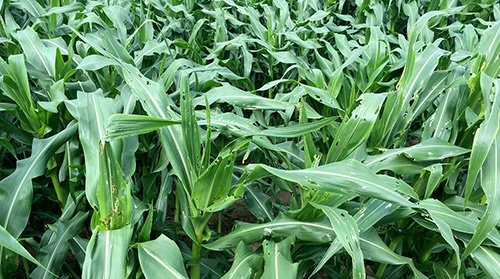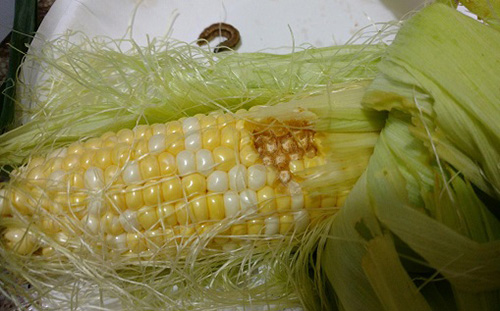Fall armyworm has arrived in Michigan corn
Fall armyworm can damage the leaves and ears of late-season sweet corn.

I recently detected fall armyworm in southeast Michigan sweet corn, and I’ve heard reports of it in other parts of the state. Fall armyworm is a pest of sweet corn, seed corn and popcorn that can often go unnoticed since growers focus their spray programs on corn earworm. Like corn earworm, fall armyworm is unable to overwinter in Michigan, and doesn’t appear in Michigan until August because it takes time for southern populations to develop and flights to arrive in our region.
Once they arrive in Michigan, female moths lay multiple egg masses on corn, which contain up to 200 eggs and are covered in white hairs. The young larvae hatch en masse and begin feeding. Larvae will molt multiple times and grow from 0.1 inch up to 1.5 inches in length, with color varying from green to cream to black.
The easiest way to identify fall armyworm is the distinctive Y on the head capsule (Photo 1). Larvae will generally be found clumped in certain areas of the field feeding on whatever part of the plant is tender and growing, so larvae will start by feeding on leaf whorl and tassel (Photo 2) and will move to the ear. They may do this through the side of the husk, which can be hard to detect, or may enter through the silks, which causes easy-to-stop damage and jagged holes. The damage to the ear itself often looks like a human took a bite out of the ear (Photo 3).

Photo 2. Clump of fall armyworm-infested sweet corn plants. Investigation into the whorl will reveal frass, and with enough digging, the caterpillar. Photo: Marissa Schuh, MSU Extension.

Photo 3. Fall armyworm has damaged this sweet corn ear. Photo: Ben Phillips, MSU Extension.
When looking for fall armyworm damage in corn, keep in mind the feeding habit and biology. Fall armyworm rarely appears in Michigan before mid-July and prefers to feed on the most tender parts of the plants. They will not damage the stalk, so Michigan State University Extension suggests focusing scouting efforts on the leaf whorl and developing tassel. You can scout for European corn borer and western bean cutworm at the same time that you look for this pest, though these are usually detected in traps.
What should you look for when scouting? Fall armyworm are messy eaters, and an occupied whorl will likely be full of frass (Photo 1). Because this pest is not consistently widespread and may not appear every year, hard and fast thresholds do not exist for this part of the country. Purdue University Extension recommends scouting if you’ve seen signs of damage, and suggests surveying 20 plants at five locations, factoring in damaged plants within and out of your sampling areas when estimating the percent of plants infested. If you’ve had a history with this pest, you can use pheromone lures and green bucket traps to monitor moth populations. Trap catches can provide a cue that it’s time to examine corn for damage. If moths are being caught in traps or larval damage is present, treatment should be considered. Extension in Ontario and New York recommend treatment if 15 percent of plants are infested with fall armyworm.
General strategies for treatment will be similar to European corn borer, just make sure control is attempted during the right plant stage. The late-whorl tasseling stage is the best time to target fall armyworm, and you want to make sure the tassel is starting to emerge so the treatment can reach the caterpillar.



 Print
Print Email
Email

